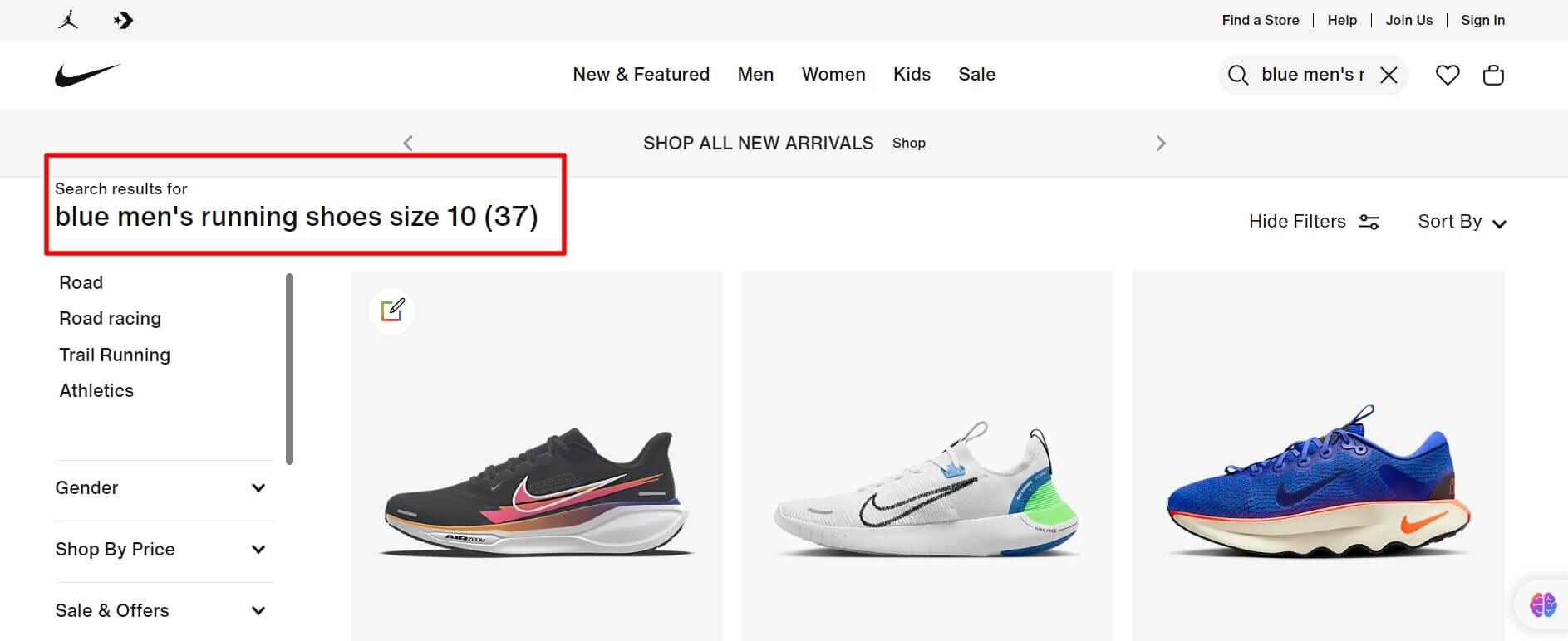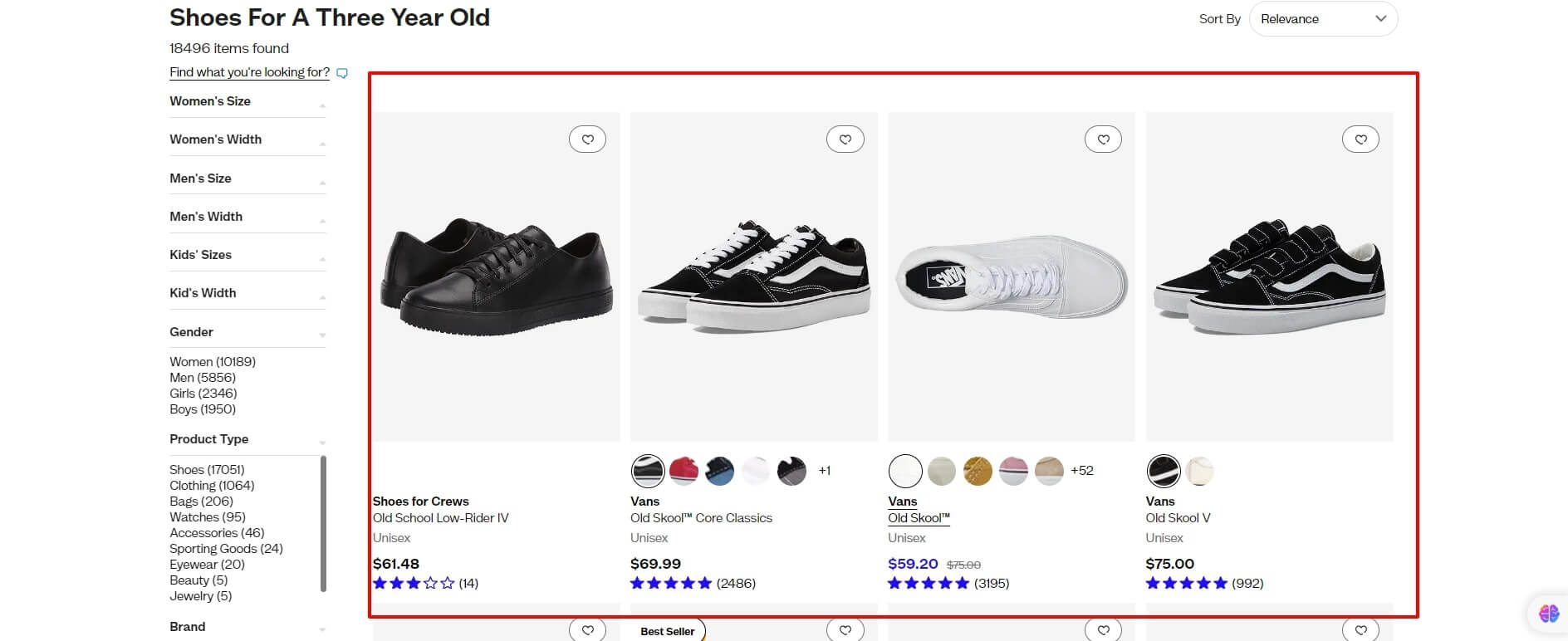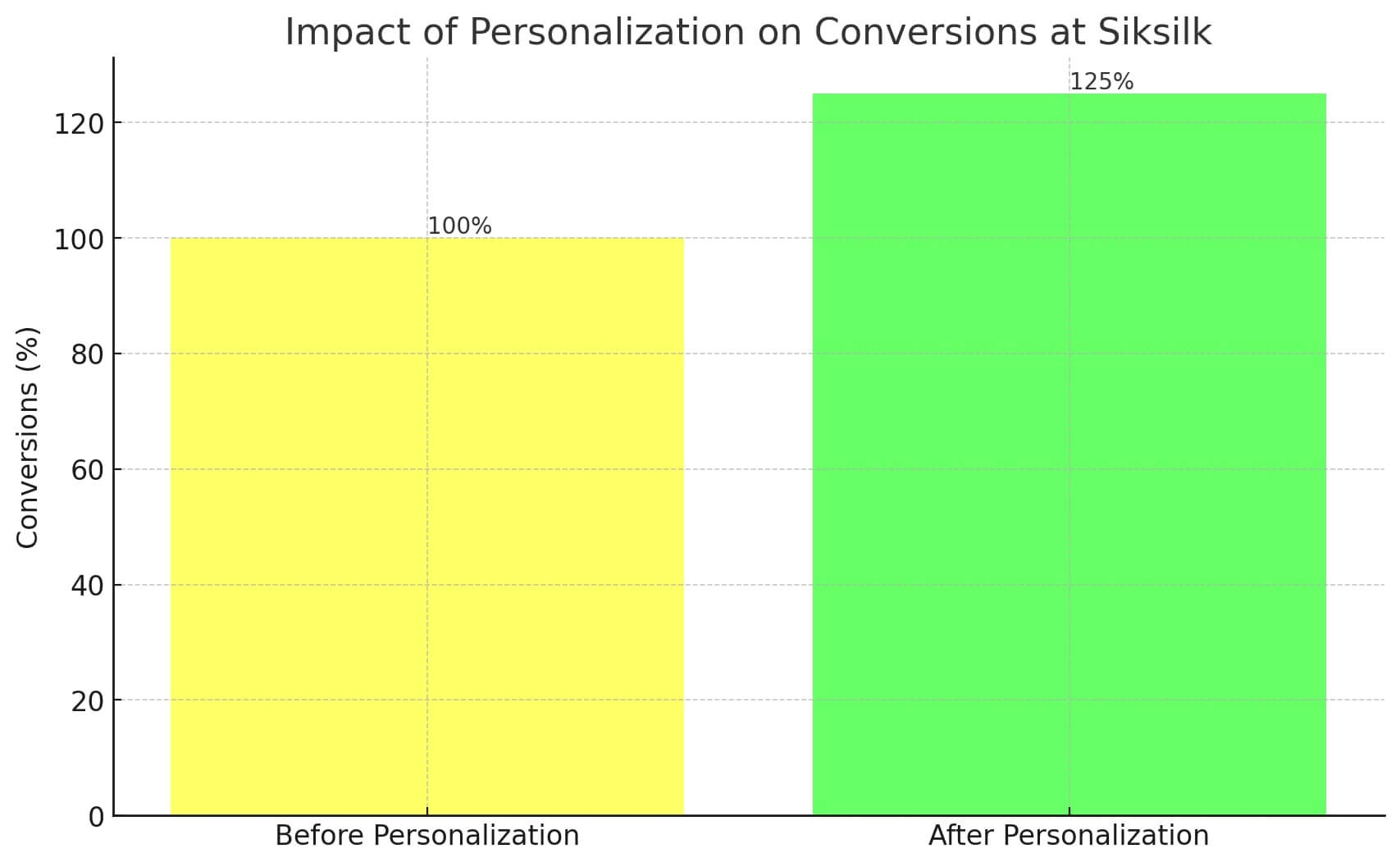
Are you an e-commerce entrepreneur? Imagine losing customers because they couldn't find what they wanted—don't let that be you! With 43% of retail customers heading straight to the search bar on a website, you cannot miss out on the opportunity of a great search algorithm. It makes shopping a breeze for your users and turns casual browsers into buyers. But, if your ecommerce search algorithm isn't up to par, you risk losing sales and frustrating your customers. This article will expose why a powerful search tool is the secret weapon your e-commerce platform needs to stay ahead.
What is an E-commerce Search Algorithm?

An e-commerce search algorithm is a set of rules and processes that help you find what you’re looking for on an online shopping site. It’s like the brain behind the search bar. But how does it work? First, the algorithm processes your query when you type something into the search bar. Then, it searches through the store’s database of products to find matches. Instead of just showing you everything that matches your keywords, the algorithm sorts and ranks the results. It considers various factors, like the popularity of the products, their relevance to your search terms, and even your past shopping behavior. Let's just say the algorithm delivers the most relevant and personalized results, making it easier for you to find exactly what you’re looking for quickly and efficiently. This smart processing and retrieval of information is what makes e-commerce search algorithms so powerful and essential for a good shopping experience.
Difference Between Search and Search Algorithm
Although search and search algorithms may be used interchangeably, they do not mean the same thing. When you use the search bar on an online store, you’re experiencing basic search functionality. This means the search is using simple keyword matching and basic filtering. For example, if you type "red dress," the search will look for any products with those exact words and show you all the red dresses it finds. It's straightforward to use, but it doesn't go beyond matching the words you typed in.

On the other hand, a search algorithm is a more advanced way of searching. It involves complex processes to make search results more accurate and useful. These algorithms use indexing, which organizes data in a way that makes it easier to find. They also use relevance ranking to show the most useful results first. Personalization is another feature, where the algorithm learns from your past searches to show results that are more likely to interest you. Hence, the main difference lies in their complexity and accuracy. A basic search might just show you everything that matches the keywords, while an advanced search algorithm will rank the results by relevance and personalize them for you. For instance, a basic keyword search for "running shoes" will show you all running shoes available on the site. In contrast, a personalized search algorithm will display running shoes that fit your size, preferred brand, and even those on sale based on your previous shopping behavior.
How Do E-commerce Search Engines Work?
Ecommerce search engines are designed to help users find products quickly and on shopping websites. How does this happen? Through the steps below:
- Crawling: This is the first step where the search engine sends out "crawlers" or "bots" to scan all the pages on the ecommerce website. These bots collect information about each product, including titles, descriptions, prices, and images.
- Indexing: After crawling, the collected data is organized in a structured way. This is called indexing. The index is like a huge catalog where each product is stored with its details, making it easy to retrieve later.
- Storing: The indexed data is then stored in a database. This storage allows for quick access whenever someone searches for a product.
- Query Processing and Result Retrieval: When a user types a query, the search engine processes it by breaking it down into keywords. It then searches the index for products that match these keywords. The matching products are retrieved and shown as search results.
Role of Search Algorithms
Search algorithms play a key role in helping you find what you’re looking for on an e-commerce site. Firstly, they determine relevance by analyzing the keywords you use and matching them with product descriptions, titles, and other data. Then, they rank these results based on how well they match your query. Popularity, user reviews, and other criteria also play a part in deciding which products show up at the top. Another role that search algorithms play is integrating machine learning and AI. It's a known fact that many e-commerce platforms use machine learning and AI to make searches even better. These technologies help the algorithm learn from past searches and improve over time. For example, if you often search for eco-friendly products, the algorithm will start showing you more of those options.
Types of Queries Handled by E-commerce Search Engines
In e-commerce, search engines handle a variety of queries to help you find exactly what you're looking for. These are some common types:
1. Product Searches
While searching for a product, you can probably type in the following:
- Product Name: Users often search using the exact name of the product they are looking for. The search algorithm must handle variations in spelling and common typos, leveraging techniques like fuzzy matching to ensure relevant results are displayed even if the user makes a mistake.
- Category: Category searches allow users to find products within a specific group, such as "men's shoes" or "kitchen appliances." The search engine must understand category hierarchies and relationships to accurately return relevant products.

- SKU (Stock Keeping Unit): When users search by SKU, they expect precise results. The search engine needs to maintain an up-to-date index of SKUs and ensure that queries are matched exactly to the corresponding product.
2. Category Searches
Here, you'll have to browse through different product categories such as:
- Hierarchical Navigation: Users can browse through categories that are organized in a hierarchical manner (e.g., Electronics > Computers > Laptops). The search engine must support dynamic category trees that update as new products are added or categories are restructured.
- Faceted Navigation: This allows users to refine their category search using facets such as brand, price range, and customer ratings. Faceted navigation requires the search engine to handle complex queries seamlessly combining multiple attributes.
3. Keyword Searches
There are two types of keyword searches. They include:
- Basic Searches: Involves simple keyword matching where the search engine looks for products containing the exact keywords entered by the user. This includes basic relevance ranking to prioritize products that more closely match the search terms.
- Advanced Searches: Involves handling complex keyword queries that might include Boolean operators (AND, OR, NOT), phrase searches (exact match within quotes), and wildcard searches. The search algorithm should be able to parse and interpret these advanced queries accurately.

4. Natural Language Searches
Handling conversational queries using NLP involves the following:
- Understanding Intent: Natural Language Processing (NLP) enables the search engine to understand the intent behind user queries, even if they are phrased in conversational language. For example, "show me red dresses under $50" should be parsed to understand the color, category, and price range.
- Contextual Relevance: NLP helps in understanding context and synonyms, ensuring that the search engine can return relevant results even if the exact keywords are not present in the product descriptions. For instance, a query for "affordable laptops" should match products listed as "budget-friendly laptops."
5. Filtered and Faceted Searches
This involves using filters and facets to narrow down search results. Here's how it's done:
- Filters: Users apply filters to narrow search results based on specific attributes such as price, brand, size, color, and more. The search engine must efficiently apply these filters to large datasets without compromising performance.
- Facets: Faceted search allows users to refine their search results by selecting multiple attributes simultaneously. For example, a user might filter products by selecting both "Nike" and "Adidas" under the brand facet, along with a price range. The search algorithm should support multi-faceted queries and dynamically update available facet options based on the current selection.
Handling Complex and Multi-Attribute Queries
Search engines go through a lot of queries in nanoseconds. They are:
- Multi-Attribute Queries: E-commerce search engines often need to handle queries that combine multiple attributes. For example, a user might search for "blue men's running shoes size 10." The search engine must parse this query and understand each attribute (color, gender, product type, size) to return the appropriate results.

- Dynamic Facet Updates: As users apply filters, the search engine must dynamically update the available facets. For instance, if a user selects "size 10" in the shoe category, the engine should only display brands, colors, and price ranges that have products available in size 10.
Core Components of E-commerce Search Algorithms
For an e-commerce search algorithm to work perfectly, it is usually made of different components. They include;
1. Indexing and Crawling
Before data is indexed and made searchable, there are some processes. They include:
- Crawling: The process begins with crawling, where the search engine systematically scans and collects data from the ecommerce site's database. This includes product descriptions, categories, images, prices, and other relevant metadata.
- Indexing: Once the data is collected, it is organized into an index, a structured format that allows for quick retrieval. The index acts like a library catalog, enabling the search engine to find and display relevant results swiftly. It includes inverted indexes where terms are mapped to their corresponding documents (products).
- Data Structuring: The indexing process involves structuring the data to support efficient searching. This includes tokenizing text into individual words or phrases, normalizing data to a consistent format, and creating relationships between different data points (e.g., linking products to categories).
Importance of Frequent Updates to the Index
- Real-Time Indexing: To ensure the search results are always up-to-date, real-time indexing is essential. This involves continuously updating the index as new products are added, prices change, or inventory levels are updated.
- Batch Indexing: For large datasets, periodic batch indexing can be used to refresh the index. This ensures that any changes made to the product catalog are reflected in the search results.
- Handling Dynamic Data: E-commerce sites often have dynamic content. Frequent updates to the index ensure that promotions, new arrivals, and stock changes are promptly reflected, providing users with the most current information.
2. Query Processing
These are some steps involved in processing a search query. They are:
- Parsing: When a user enters a search query, the search engine first parsers the query to understand its structure and intent. This involves breaking down the query into individual components such as keywords, filters, and operators.
- Normalization: The query is then normalized to a consistent format. This includes converting text to lowercase, removing special characters, and standardizing terms (e.g., converting plural words to their singular form).
- Stemming and Lemmatization: Stemming and lemmatization are applied to improve matching accuracy. Stemming reduces words to their base forms (e.g., "running" to "run"), while lemmatization considers the context to convert words to their base forms (e.g., "better" to "good").
- Synonym Handling: The search engine expands the query using synonyms to capture a broader range of relevant results. For instance, a search for "laptop" might also include results for "notebook."
3. Relevance Ranking
Here are some factors influencing the ranking of search results:
- Term Frequency-Inverse Document Frequency (TF-IDF): This algorithm ranks documents based on the frequency of search terms relative to their occurrence across all documents. It helps in identifying the most relevant products by giving higher importance to terms that are less common across the dataset but frequently appear in the specific document.
- BM25: An advanced ranking algorithm that considers term frequency, document length, and overall term saturation. BM25 is highly effective for e-commerce search as it balances relevance and retrieval efficiency.
- Vector Space Models: These models represent documents and queries as vectors in a multi-dimensional space. The relevance is determined by the cosine similarity between the query vector and document vectors, allowing for precise matching of search terms with product attributes.
- User Behavior and Click-Through Data: Factors such as past user interactions, click-through rates, and conversion rates are also considered to rank products that are more likely to satisfy the user's intent.
4. Personalization and Recommendations
This entails tailoring search results based on user behavior and preferences in ways such as:
- Behavioral Data: The search algorithm collects and analyzes data on user behavior, such as past searches, clicks, and purchase history. This data is used to personalize search results, showing products that align with the user's preferences and shopping habits.
- Collaborative Filtering: This technique recommends products based on the behavior of similar users. For example, if users who bought item A also bought item B, the algorithm might recommend item B to someone interested in item A.
- Content-Based Filtering: This method recommends products that are similar to those the user has previously interacted with. It relies on analyzing product attributes and user preferences to make accurate recommendations.
Techniques for Implementing Effective Personalization
- Real-Time Personalization: Adjusting search results dynamically as the user interacts with the site, providing immediate and relevant recommendations.
- User Segmentation: Grouping users based on shared characteristics and tailoring search results to meet the specific needs of each segment.
- Machine Learning Models: Leveraging machine learning to improve personalization by learning from user interactions and feedback.
- Contextual Recommendations: Understanding the context of the user’s search query and session to offer relevant product suggestions. For instance, recommending winter clothing when the user is browsing during the winter season.
- Multi-Channel Data Integration: Incorporating data from various channels (e.g., web, mobile, in-store) to create a comprehensive user profile, ensuring consistent and personalized search experiences across all platforms.
5. Data Analytics and Feedback Loop
This is the ability for your search engines to use analytics to improve search performance by doing the following;
- Search Analytics: Tracking and analyzing search queries, click-through rates, and conversion rates to understand user behavior and search performance. This data provides insights into how users interact with the search function and where improvements can be made.
- A/B Testing: Conducting experiments with different search algorithms and configurations to determine which versions yield the best results. This helps in refining the search experience based on empirical evidence.
- Error Analysis: Identifying and analyzing search queries that result in no or poor results to understand common issues and improve the search algorithm.
Continuous Feedback Loop for Algorithm Refinement:
Your e-commerce search algorithm will always need continuous checks to ensure things are running smoothly; below is the right way to do that;
- User Feedback: Collecting direct feedback from users about their search experience. This can be through ratings, comments, or surveys. User feedback is invaluable for identifying pain points and areas for improvement.
- Automated Feedback Mechanisms: Implementing systems that automatically detect and report anomalies in search performance, such as sudden drops in relevance or accuracy.
- Regular Algorithm Updates: Continuously update and fine-tune the search algorithm based on analytics and feedback. This ensures that the search engine evolves to meet changing user expectations and business needs.
- Performance Monitoring: Continuously monitoring key performance indicators (KPIs) such as search speed, accuracy, and user satisfaction to ensure the search algorithm maintains high standards.
- Iterative Improvement: Employing an iterative approach to make incremental improvements to the search algorithm. Each iteration incorporates learnings from the previous cycle, driving ongoing enhancement in search performance.
5 Apps That Provide Modern Search Algorithms
You may be wondering what Apps can aid you in making a perfect search algorithm for your e-commerce business. We have compiled the best five apps that provide you with a modern search Algorithm, they are;
1. Sparq

Sparq makes it easy for customers to find products quickly and without hassle in online stores. It uses advanced AI and machine learning to help improve product searches and increase sales.
Features
- Predictive Search
- Faceted Search
- Personalization
Benefits
- Improved search accuracy
- Enhanced user experience
- Real-time search analytics.
Practical applications and case studies
An online fashion retailer can use Sparq.ai to help customers find products based on detailed and complex queries, such as "red summer dress with floral patterns and V-neck.” How will this help? Improved product discovery leads to increased user satisfaction and higher conversion rates as customers quickly find items that match their specific criteria.
2. Algolia

Algolia offers a search and discovery platform that uses artificial intelligence. This platform uses natural language processing and keyword matching to deliver quick and relevant search results. It can create search functions for websites, mobile apps, and voice applications.
Features
- Instant search
- Typo tolerance
- Multi-language support
Benefits
- High-speed search
- Customizable ranking
- Scalability
Real-world examples of successful implementations
Rover, a pet care platform, used Algolia to improve development speed and handle the demands of their growing business. This resulted in a faster search experience for pet owners looking for sitters
3. Yext

Yext is a search-as-a-service platform that helps businesses direct potential customers to the right products or content. It works whether customers are searching on the company’s website or using voice assistants.
Features
- Natural language processing
- Real-time data updates
- Location-based search
Benefits
- Enhanced local search capabilities
- Integration with other platforms.
Practical use cases and success stories
KFC uses Yext to manage its online listings across various platforms, ensuring accurate and up-to-date information for customers searching for nearby locations and menus.
4. Coveo

Coveo has created a cloud-based AI search and recommendation platform to improve digital experiences. The platform uses semantic search, machine learning recommendations, and natural language processing. It helps companies improve their customer websites and internal knowledge portals.
Features
- AI-powered search
- Content recommendations
- Analytics
Benefits
- Personalized search experiences
- Actionable insights
Case studies demonstrating effectiveness in e-commerce
Eddie Bauer, an outdoor apparel retailer, uses Coveo to personalize product recommendations and search results based on a customer's browsing history and past purchases.
5. Bloomreach

Bloomreach is a platform made for eCommerce, focusing on product discovery and important features like marketing automation and content management. It offers tools to help businesses create great online shopping experiences for their customers.
Features
- Commerce-specific search
- User intent prediction
- Advanced merchandising
Benefits
- Increased conversion rates
- Improved customer engagement.
Practical examples of deployment and impact
Staples, a leading office supply store, uses Bloomreach to improve search accuracy and suggest relevant products alongside customer searches. This has resulted in a significant increase in their conversion rate.
Strategies to Improve Search Algorithms
Enhancing search algorithms is crucial for delivering accurate and relevant results to users. Here are the best 7 ways to improve your search algorithms;
Regular Updates and Refinement
Regular updates help keep your search results accurate and relevant. Usually, trends change, new products are released and customer preferences shift. Updating your algorithms ensures they can handle these changes and provide the best results. Before rolling out updates, test them to see how they perform. Use real search data to check if the changes make searches faster or results more accurate.
Utilizing Machine Learning and AI
Machine learning and AI are very important if you want to improve search algorithms. This makes search results more accurate and helpful. To integrate them into your ecommerce platform, you'll have to collect customer data. Then, use AI to analyze this data and improve your search results. You will need help from AI experts to set this up.
Implementing Natural Language Processing (NLP)
Another way of improving search algorithms is through Natural Language Processing (NLP). It helps search algorithms understand and process human language. This is very useful for handling conversational queries and complex search terms. If you want to effectively implement NLP, you'll have to use techniques that expand the user’s query to include synonyms and related terms.
Enhancing Indexing and Crawling Efficiency
Efficient indexing and crawling are very important for a good search algorithm. Regardless, it needs to be constantly improved to get the desired results. So, instead of reindexing the entire database, update only the parts that have changed. If you're handling a large dataset, you should use scalable infrastructure that can handle large volumes of data. Most people recommend cloud-based solutions for this. Also, make sure the indexing process runs regularly to keep the dataset current. This is necessary for websites with content that are changed frequently.
Personalizing Search Results
Personalization increases the relevance of search results on your ecommerce platform by considering your customer's preferences. You can capture this data by creating profiles based on user interactions and preferences. If you want to improve the search algorithm on your website through personalization, you can use recommendation engines that analyze user data to suggest relevant search results and products. Another option is to ask your customers for feedback. This feedback will be used to improve the personalization of search results.
Why is it Important to Have a Good Search Algorithm?
Adopting a good search algorithm will be beneficial to your business and customers in numerous ways. They include:
Improved User Experience
A good search algorithm makes it easier for users to find what they are looking for. Accurate search results save users time and effort, leading to a better experience on your website or app. When users get relevant results quickly, they are more likely to feel satisfied and happy with their visit. For example, Zappos' advanced search algorithm makes shoe shopping very easy.

Increased Conversion Rates
It is not very wise to let your customers struggle to find products on your website. When people find what they want quickly, they’re more likely to buy. In 2024, businesses recognize the power of a well-optimized search function to boost conversions. For instance, Siksilk, a fashion retailer, saw a 25% increase in conversions by personalizing search and offering recommendations.

Higher Customer Retention and Loyalty
When customers easily find what they're looking for, they're less frustrated. This positive association with the brand makes them return for future purchases. For instance, Amazon is known for its advanced search algorithm. Maybe that's why it's one of the big guys when it comes to ecommerce. The presence of predictive search, lots of product categories, and user reviews on their platform contribute to providing a good user experience, thereby leading to customer retention and loyalty.

Better Handling of Complex Queries
Complex and long-tail queries can be tricky for search engines to interpret. The key lies in getting into the user's head and analyzing search terms to know what they want. You can also use NLP, semantic search, and user data to understand complex queries. Algorithms also learn from past searches to improve future search results, making them more accurate over time. An example is Zalando, a European online fashion retailer that uses advanced search algorithms and natural language processing to handle complex queries. For example, if you type in “Women's red leather ankle boots with a low heel and zipper”, it will filter the results to show only the products that match all these criteria.

Enhanced Data Insights and Business Intelligence
Search data gives valuable insights into user preferences. It shows what people want and how they shop. Analyzing this helps predict trends and stock products customers love. Retailers like Best Buy use search analytics to stock popular items. This boosts sales and keeps customers happy, which is a win-win for any business.
Conclusion
While basic search functionality might get you by, e-commerce businesses looking to thrive need to prioritize advanced search solutions. By understanding user intent, leveraging AI and advanced algorithms, and keeping pace with trends like voice and visual search, businesses can create a search experience that delights customers, keeps them coming back for more, and ultimately fuels long-term success. Don't let your customers get lost in a product maze. You can reach out to us if you want to invest in your e-commerce platform and watch your sales soar!
FAQs
Which of the following is not a factor search engines consider when ranking search results?
Search engines do not consider factors like the color of a website or the font style used when ranking search results.
What is the algorithm of eCommerce?
The algorithm of eCommerce is a set of rules and calculations that helps online stores show relevant products to customers based on their searches and preferences.
How does search work in eCommerce?
In eCommerce, search works by using a program that looks through the online store’s products and shows the most relevant ones based on what the customer types in the search bar.
What algorithm does Google use for searching?
Google uses a complex algorithm called PageRank along with many other factors to find and show the most relevant results for a search query.
